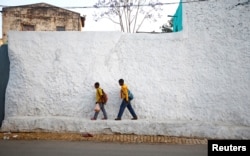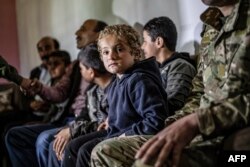VOA’s Carol Van Dam Falk contributed to this report.
At a time when bad news seems inescapable, the aid group Save the Children has some good news: Across the globe, children are healthier and safer than ever before.
According to a new report by the U.S.-based charity, the overall situation for children has improved in 173 of 176 countries since 2000. Among the highlights are 4.4 million fewer child deaths per year, 115 million more children in school and 11 million fewer married girls.
“We found that there stands some remarkable progress in helping children to grow up healthy, educated and safe,” said Carolyn Miles, CEO of Save the Children. “And I think the headline from the report is that an estimated 280 million children worldwide are significantly better off today than they were in the year 2000.”
To quantify the status of children, the group created an “End of Childhood” index and ranked countries on a 1,000-point scale. The scores reflect “childhood enders,” including death, severe malnutrition, child marriage, labor and early motherhood.
In Africa, the group found reason for optimism. More than 70% of African countries saw their scores increase by 100 points or more. Sierra Leone, Rwanda, Ethiopia and Niger made the greatest gains.
“In most of these cases, you can get strong political commitment from the very top,” Nikki Gillette, one of the report’s researchers, said.
Each of the African countries highlighted had specific drivers improving the quality of life for children. In Sierra Leone, the end of a protracted civil war led to a 99% reduction in displaced people. In Rwanda, a return to peace and several government initiatives led to a 79% drop in child mortality and a 60% reduction in child marriage and “out of school” rates.
In Ethiopia, a commitment to the U.N. Sustainable Development Goals has led to improved health of mothers and children. Miles said, 20 years ago in Ethiopia, Save the Children was primarily focused on saving the lives of young children. Now, the problems are less severe, and the group can focus on other indicators.
“The [Ethiopian] government has taken up a lot of that community health work, and the child mortality rate has dropped by 54%,” Miles said. “So the work that Save the Children is doing there now is more focused on making sure that kids get basic literacy and have all the skills they need in school, and also training youth.”
Some scores drop
But the news wasn’t good everywhere. Syria, Venezuela, and Trinidad and Tobago’s scores dropped between 2000 and 2019. Syria has been in civil war for nine years, Venezuela has undergone a political crisis leading to widespread food shortages and, in Trinidad and Tobago, increased malnutrition has led to higher levels of stunting among children.
The report also noted a steep rise in the number of children living in conflict zones. Since 2000, the number of people forced to flee their homes due to conflict has increased by 80%, totaling about 30.5 million more people.
“That’s where we see, really, the indicators not going in the right direction,” Miles said.
In fact, Miles added, the five countries recording the worst mortality rates for children under five — the Central African Republic, Chad, Mali, Sierra Leone and Somalia — are all either at war or have recently come out of war.
“We released a report earlier this year that estimated that 120 million children were living in areas affected by conflict at the end of 2017,” Miles said. “And the impact on kids is more than just the impact from bombs and bullets.”










